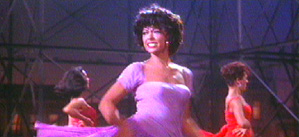| Release List | Reviews | Price Search | Shop | Newsletter | Forum | DVD Giveaways | Blu-Ray/ HD DVD | Advertise |
| Reviews & Columns |
|
Reviews DVD TV on DVD Blu-ray International DVDs Theatrical Reviews by Studio Video Games Features Collector Series DVDs Easter Egg Database Interviews DVD Talk TV DVD Talk Radio Feature Articles Columns Anime Talk DVD Savant HD Talk Horror DVDs Silent DVD
|
DVD Talk Forum |
|
|
| Resources |
|
DVD Price Search Customer Service #'s RCE Info Links |
|
Columns
|
 |
WEST SIDE HISTORIES
 The recent DVD release of WEST SIDE STORY presents a good opportunity to relate some little-known facts about this incredibly entertaining picture. Winner of the 1961 Best Picture Oscar and uniformly praised from the day of its release, WEST SIDE went against the musical trend of the times. After 20 years of developing their own cinematic genre, in the 50's, musicals began to revert to once again being simply film versions of stage presentations. OKLAHOMA! is undeniably a great entertainment, but unlike many of the earlier Hollywood-originated musicals, there is nothing very cinematic about it. One is constantly aware that a stage show has been 'opened up', with the addition of realistic settings, i.e, the prairie. For the most part the camera just sits still and records the songs and dances as they were envisioned for the stage. Even more stage-like is SOUTH PACIFIC, which adopted over from the theater a rigid lighting stylization. It suffused its musical numbers in various amber, yellow and purple hues, mood lighting perfectly suited for the stage, but simply distracting on a screen. The makers of WEST SIDE STORY seemed acutely aware that success would require a different approach: to re-invent the show for film, as opposed to just 'opening it up'. Perhaps following the example of the successful Abbott-Donen-Fosse collaborations on PAJAMA GAME and DAMN YANKEES, a unique plan was devised: a co-directorship. Choreographer Jerome Robbins, acknowledged as the innovative genius behind the dazzling stage productions of WEST SIDE, was hired at the full rank of director, to be responsible for the presentation of the musical numbers. Since Robbins had never before directed, Robert Wise came on as co-director. A master planner with a reputation for tackling gritty subjects and bringing in movies under budget, Wise seemed a perfect choice. What is not a secret, but most viewers don't seem to know, is that Jerome Robbins was dismissed from WEST SIDE, a little more than halfway through shooting. A perfectionist, Robbins' big musical numbers began to go radically over schedule. Although all concerned were amazed at the quality of what was being shot, Robbins was dropped from the film after completing most of the big production numbers. 'The Dance at the Gym' was one number filmed after his exit. Another interesting WEST SIDE puzzle is the dubbing of its songs. Associate producer Saul Chaplin (who, like Mr. Robbins, recently passed away) was well known in his Hollywood musicals for revoicing singing roles. Sometimes this was done to provide non-singing stars with Broadway-caliber voices, but personal taste and studio politics seem to have played a big part as well, as in the well-documented revoicing of Ava Gardner for SHOWBOAT. In WEST SIDE, Saul really went to town. The incredibly versatile Marni Nixon dubbed Natalie Wood's singing, and also some really high notes for Rita Moreno in the finale of the 'Quintet', the medley just before the rumble. Richard Beymer, who played Tony, was sung by Jim Bryant. Elsewhere the reasoning for replacing vocals is less clear. Rita Moreno was dubbed for 'A Boy Like That' by Betty Wand. Russ Tamblyn's entire vocal performance for the 'Jet Song' was redubbed by Tucker Smith, who played 'Ice'. A couple of other notes to ponder while watching the beautiful new DVD of WEST SIDE STORY: Before filming, elaborate tests were done with the ballet-trained 'juvenile delinquents' dancing in the streets of tough neighborhhoods in Los Angeles, just to see what it would look like. In New York, blocks of real West Side tenements being cleared for an Urban Renewal project were used for filming. As the shooting schedule dragged out, the number of remaining buildings dwindled until empty vistas of rubble were just out of camera range. Part of WEST SIDE's location eventually became Lincoln Center.
Source: Peter Fitzgerald, producer of THAT'S ENTERTAINMENT III. Text © Copyright 1998 Glenn Erickson
Review Staff | About DVD Talk | Newsletter Subscribe | Join DVD Talk Forum |
|
| Release List | Reviews | Price Search | Shop | SUBSCRIBE | Forum | DVD Giveaways | Blu-Ray/ HD DVD | Advertise |





